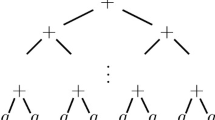Abstract
A type of abstract computing machine and a measure of complexity of computations on this machine are constructed in a natural way with Grzegorczyk's hierarchy. To define this type of machine the recursive construction present in the original definition of Grzegorczyk classes is not needed. All the Grzegorczyk classes
for n=0, 1, 2, 3,... turn out to be complexity classes for the indicated type of machines and the indicated measure of complexity. On the basis of similar machines one also gets a complexity description of Smullyan's class of rudimentary predicates. With the help of the machine studied, one proves the coincidence on predicates with
of certain subclasses of
, based on bounded recursion. For the class of unary functions from
and certain similar classes, the absence is proved of a finite basis with respect to composition. It is proved that the equation
implies the equation
.
Similar content being viewed by others
Literature cited
A. Grzegorczyk, “Some classes of recursive functions,” Rozpr. Mat.,4, Warszawa (1957).
R. W. Ritchie, “Classes of predictably computable functions,” Trans. Am. Math, Soc.,106, 139–173 (1963).
Ya. B. Kazanovich, “Classification of primitively recursive functions with the help of Turing machines,” Probl. Kibern.,22, 95–106 (1970).
D. Rödding, “Über die Eliminierbarkeit von der Definitionsschemata in der Theorie der rekursiven Funktionen,” Z. Math. Logik Grundl. Math.,10, No. 4, 315–330 (1964).
S. S. Marchenkov, “Elimination of recursion schemes in Grzegorczyk's class,” Mat. Zametki,5, No. 5, 561–568 (1969).
A. A. Muchnik, “Two approaches to the classification of recursive functions,” in: Problems of Mathematical Logic [in Russian], Moscow (1970), pp. 123–138.
A. P. Bel'tyukov, “Iterative description of a class of Grzegorczyk's hierarchy,” Zap. Nauchn. Sem. Leningr. Otd. Mat. Inst. Akad. Nauk SSSR,60, 3–14 (1976).
A. P. Bel'tyukov, “Maximal sequence of classes transforming a primitive recursion in a given class,” Zap. Nauchn. Sem. Leningr. Otd. Mat. Inst. Akad. Nauk SSSR,68, 3–18 (1977).
R. E. Stearns, J. Hartmanis, and P. M. Lewis, II, “Hierarchies of memory limited computations,” in: IEEE Conf. Rec. Symp. Switch. Circuit Theory and Logic Design, New York (1965), pp. 170–190.
S. S. Marchenkov, “Skolem elementary functions,” Mat. Zametki,17, No. 1, 133–142 (1975).
V. A. Nepomnyashchii, “Rudimentary simulation of undetermined computations,” Kibernetika, No. 2, 23–29 (1973).
Y. Yu, “Rudimentary relations and formal languages,” Ph. D. Dissertation, University of California, Berkeley (1970).
R. M. Smullyan, Theory of Formal Systems, Princeton (1961).
S. V. Pakhomov, “Proof of the noncoincidence of classes of simple primitive recursive functions,” Zap. Nauchn. Sem. Leningr. Otd. Mat. Inst. Akad. Nauk SSSR,68, 115–122 (1977).
Additional information
Translated from Zapiski Nauchnykh Seminarov Leningradskogo Otdeleniya Matematicheskogo Instituta im. V. A. Steklova AN SSSR, Vol. 88, pp. 30–46, 1979.
The author expresses gratitude to his scientific instructor N. K. Kosovskii for the interest displayed in the work.
Rights and permissions
About this article
Cite this article
Bel'tyukov, A.P. A machine description and the hierarchy of initial Grzegorczyk classes. J Math Sci 20, 2280–2289 (1982). https://doi.org/10.1007/BF01629435
Received:
Issue Date:
DOI: https://doi.org/10.1007/BF01629435




